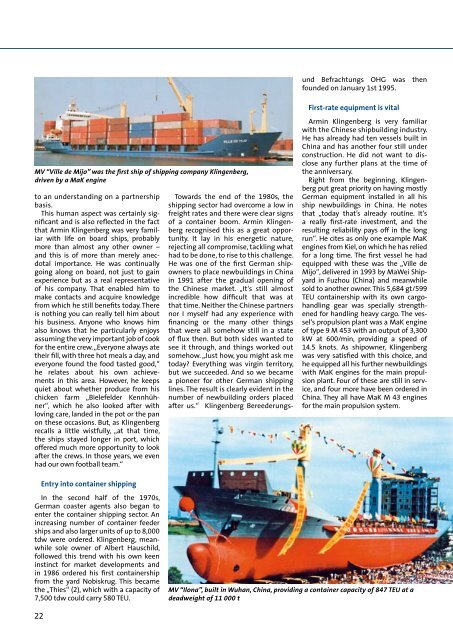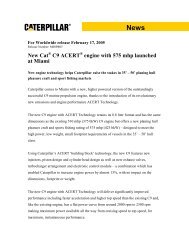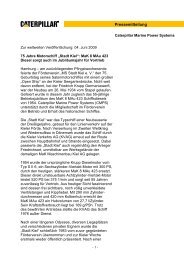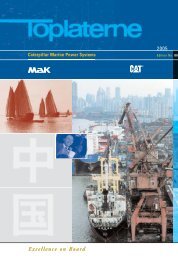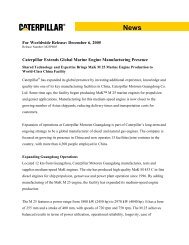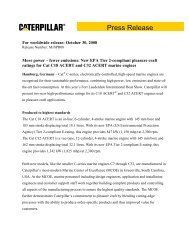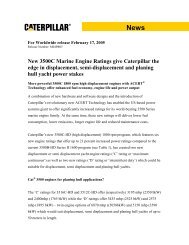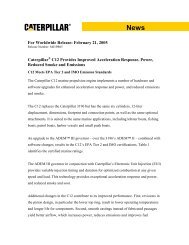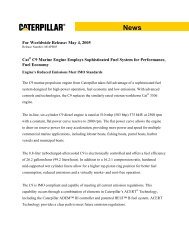Caterpillar Marine - Marine Engines Caterpillar
Caterpillar Marine - Marine Engines Caterpillar
Caterpillar Marine - Marine Engines Caterpillar
You also want an ePaper? Increase the reach of your titles
YUMPU automatically turns print PDFs into web optimized ePapers that Google loves.
MV “Ville de Mijo” was the first ship of shipping company Klingenberg,<br />
driven by a MaK engine<br />
to an understanding on a partnership<br />
basis.<br />
This human aspect was certainly significant<br />
and is also reflected in the fact<br />
that Armin Klingenberg was very familiar<br />
with life on board ships, probably<br />
more than almost any other owner –<br />
and this is of more than merely anecdotal<br />
importance. He was continually<br />
going along on board, not just to gain<br />
experience but as a real representative<br />
of his company. That enabled him to<br />
make contacts and acquire knowledge<br />
from which he still benefits today. There<br />
is nothing you can really tell him about<br />
his business. Anyone who knows him<br />
also knows that he particularly enjoys<br />
assuming the very important job of cook<br />
for the entire crew. „Everyone always ate<br />
their fill, with three hot meals a day, and<br />
everyone found the food tasted good,“<br />
he relates about his own achievements<br />
in this area. However, he keeps<br />
quiet about whether produce from his<br />
chicken farm „Bielefelder Kennhühner“,<br />
which he also looked after with<br />
loving care, landed in the pot or the pan<br />
on these occasions. But, as Klingenberg<br />
recalls a little wistfully, „at that time,<br />
the ships stayed longer in port, which<br />
offered much more opportunity to look<br />
after the crews. In those years, we even<br />
had our own football team.“<br />
Entry into container shipping<br />
In the second half of the 1970s,<br />
German coaster agents also began to<br />
enter the container shipping sector. An<br />
increasing number of container feeder<br />
ships and also larger units of up to 8,000<br />
tdw were ordered. Klingenberg, meanwhile<br />
sole owner of Albert Hauschild,<br />
followed this trend with his own keen<br />
instinct for market developments and<br />
in 1986 ordered his first containership<br />
from the yard Nobiskrug. This became<br />
the „Thies“ (2), which with a capacity of<br />
7,500 tdw could carry 580 TEU.<br />
22<br />
Towards the end of the 1980s, the<br />
shipping sector had overcome a low in<br />
freight rates and there were clear signs<br />
of a container boom. Armin Klingenberg<br />
recognised this as a great opportunity.<br />
It lay in his energetic nature,<br />
rejecting all compromise, tackling what<br />
had to be done, to rise to this challenge.<br />
He was one of the first German shipowners<br />
to place newbuildings in China<br />
in 1991 after the gradual opening of<br />
the Chinese market. „It‘s still almost<br />
incredible how difficult that was at<br />
that time. Neither the Chinese partners<br />
nor I myself had any experience with<br />
financing or the many other things<br />
that were all somehow still in a state<br />
of flux then. But both sides wanted to<br />
see it through, and things worked out<br />
somehow. „Just how, you might ask me<br />
today? Everything was virgin territory,<br />
but we succeeded. And so we became<br />
a pioneer for other German shipping<br />
lines. The result is clearly evident in the<br />
number of newbuilding orders placed<br />
after us.“ Klingenberg Bereederungs-<br />
und Befrachtungs OHG was then<br />
founded on January 1st 1995.<br />
First-rate equipment is vital<br />
Armin Klingenberg is very familiar<br />
with the Chinese shipbuilding industry.<br />
He has already had ten vessels built in<br />
China and has another four still under<br />
construction. He did not want to disclose<br />
any further plans at the time of<br />
the anniversary.<br />
Right from the beginning, Klingenberg<br />
put great priority on having mostly<br />
German equipment installed in all his<br />
ship newbuildings in China. He notes<br />
that „today that’s already routine. It‘s<br />
a really first-rate investment, and the<br />
resulting reliability pays off in the long<br />
run“. He cites as only one example MaK<br />
engines from Kiel, on which he has relied<br />
for a long time. The first vessel he had<br />
equipped with these was the „Ville de<br />
Mijo“, delivered in 1993 by MaWei Shipyard<br />
in Fuzhou (China) and meanwhile<br />
sold to another owner. This 5,684 gt/599<br />
TEU containership with its own cargohandling<br />
gear was specially strengthened<br />
for handling heavy cargo. The vessel‘s<br />
propulsion plant was a MaK engine<br />
of type 9 M 453 with an output of 3,300<br />
kW at 600/min, providing a speed of<br />
14.5 knots. As shipowner, Klingenberg<br />
was very satisfied with this choice, and<br />
he equipped all his further newbuildings<br />
with MaK engines for the main propulsion<br />
plant. Four of these are still in service,<br />
and four more have been ordered in<br />
China. They all have MaK M 43 engines<br />
for the main propulsion system.<br />
MV “Ilona”, built in Wuhan, China, providing a container capacity of 847 TEU at a<br />
deadweight of 11 000 t


